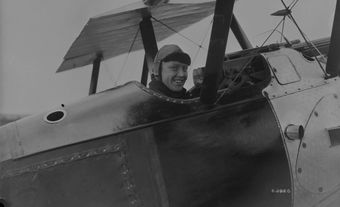Kiyooka, Roy Kenzie
Roy Kenzie Kiyooka, painter and poet (b at Moose Jaw, Sask 18 Jan 1926; d at Vancouver 8 Jan 1994). Of Japanese ancestry, Roy Kenzie Kiyooka grew up in the Prairies. He was multitalented and tackled other disciplines, including sculpture, photography, filmmaking, music and writing. He studied at the Provincial Institute of Technology and Art (now Southern Alberta Institute of Technology and Art) in Calgary from 1946 to 1949 with Jock MACDONALD. In 1956 Kiyooka spent 8 months in San Miguel de Allende in Mexico, where he was a student of James Pinto. There he was able to see the works of the great Mexican muralists Rivera, Orozco and Siqueiros. In Mexico he started to experiment in his paintings with Duco, an automobile lacquer. Having returned to Regina that fall, Roy Kiyooka began teaching at the Regina College (now the University of Regina).
Early Works
In Roy Kiyooka's early works are found forms evoking cacti or crowns of thorns, influenced perhaps by the British painter Graham Sutherland but also by the Mexican taste for such subject matter, suggesting Kiyooka's intention to express at that time a kind of stoic suffering. Being of Japanese extraction, he was registered with his family as an enemy alien in Canada during World War II and had to leave Calgary for farm work in order to survive those difficult years. A regular participant at the EMMA LAKE ARTISTS' WORKSHOPS in the 1950s, Kiyooka attended Barnett Newman's famous workshop in the summer of 1959. In the following year he began Hoarfrost, a series of nonobjective large-scale paintings on hardboard characterized by all-over white colour and criss-crossed patterning. In 1959 Kiyooka took up a teaching position at the Vancouver School of Art. During his first stay in Vancouver his painting became more hard-edge, geometric and minimal. He favoured the ellipse form and placed emphasis on colour as the prime substance of painting.
During the 1960s Roy Kiyooka's career extended to include poetry, photography, cultural animation and conceptual art. He played a leading role in Vancouver's bustling cultural scene and was involved with Intermedia, an artist-run centre. He organized poetry readings in Vancouver and later on in Montréal, a trip to Japan having triggered a renewal of his interest in oriental poetry and philosophy. Over the years Kiyooka published most of his poetry in collections, including Kyoto Airs (1964), Nevertheless These Eyes (1967), StoneDGloves (1970), transcanadaletters (1975), and The Fontainebleau Dream Machine (1977). The Pear Tree Pomes (1987) was short-listed for a GOVERNOR GENERAL'S AWARD. Mothertalk: Life Stories of Mary Kiyoshi Kiyooka, a series of interviews with his mother, was published after his death, in 1997, as was Pacific Windows: Collected Poems of Roy Kiyooka.
São Paulo Biennial
Roy Kiyooka was asked to participate in the São Paulo Biennial of 1966 and in 1969 was commissioned to create a sculpture to be displayed at the Canadian Pavilion at Expo 70 in Osaka. The VANCOUVER ART GALLERY organized a retrospective of his work in 1975. Kiyooka had an overall fruitful teaching career, having taught also in Montréal at Sir George Williams University (now CONCORDIA UNIVERSITY), in Halifax at the NOVA SCOTIA COLLEGE OF ART AND DESIGN and finally at the UNIVERSITY OF BRITISH COLUMBIA in Vancouver, from which he retired a few years before his death. A collection of Roy Kiyooka's correspondence, written between 1975 and 1985, Pacific Rim Letters, was published in 2005.

 Share on Facebook
Share on Facebook Share on X
Share on X Share by Email
Share by Email Share on Google Classroom
Share on Google Classroom


